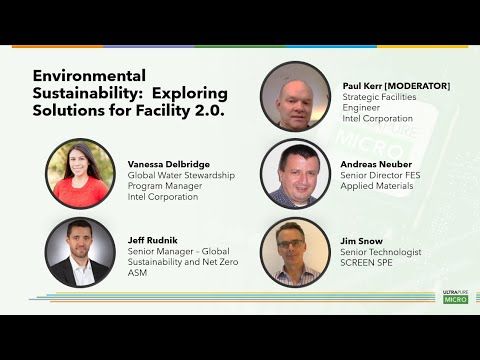
Collaborators
Sponsors

Xylem
Tags
Ion ExchangeSustainabilityThe Rising Tide of CEDI: Why it is Outshining Traditional Ion Exchange in High-Purity Applications (Part 1)
Part 1 - Sponsored Content
Share this insight
Continuous Electrodeionization (CEDI) technology is experiencing rapid growth and is taking market share from alternatives in the water treatment space, especially as sustainability goals evolve to become a key industrial priority. In industries where high purity water is critical to the final product quality – such as microelectronics, green hydrogen production, power generation, and pharmaceuticals – facility operators are increasingly adopting this water purification technology.
Part 1 of this article will explain how this technology works, and Part 2 will delve further into the reasons outlined above, in the context of a comparison to ion exchange.
Lisa Marchewka, Vice President and General Manager at Xylem told UPM: ‘The market size of our CEDI technology has doubled in size over the past five years and is taking share from the ion exchange market. ’Marchewka also emphasized that the Ionpure® portfolio of EDI modules – which was the pioneering brand to commercialize EDI for water purification – has maintained strong market presence since its inception in 1987. It has also since experienced substantial growth in the last 5-6 years, which can be attributed to continuous innovation to meet the evolving needs of customers in ultrapure water applications (a requirement in some of the fastest growing industries).
What are the multi-faceted reasons for the emergence of CEDI as such a popular alternative to well-established ion exchange systems in high-purity markets? The reasons include, but are not limited to:
Corporate sustainability goals: These are no longer just a talking point – industrial facilities are focused on reducing waste, recycling water, eliminating chemicals, and minimizing carbon footprint. CEDI can contribute to achieving all these goals at once.
Resource scarcity and labor shortage: Supply chain bottlenecks in recent years mean that material costs skyrocketed. Furthermore, facilities are significantly hindered by a shortage of trained staff. Effective facility management hinges upon efficient use of material and labor. CEDI technology requires less resin, less chemical and less attention from service providers and facilities engineers.
Consistency of operation: The busy operator can reduce the cognitive burden relating to ion exchange qualification and regeneration, since CEDI can offer consistency of operation throughout its life cycle.
Safety inside and outside industrial facilities: The reduction of exposure of humans to hazardous chemicals is an overarching priority, but high quantities of chemicals are required for traditional ion exchange.
Ultrapure water quality: Certain CEDI products can provide best-in-class removal for some ultrapure water contaminants, such as boron and silica.
Return-on-investment: Sustainability and safety does not always come at a financial cost, and CEDI can offer return-on-investment when chemical and service visit costs are cut.
Ionpure® has established itself as the firm market leader for CEDI technology and has explained to UPM the technical rationale behind industrial end users’ preference for this technology type.
How does CEDI differ from traditional ion exchange technology?
Ion exchange uses anionic and cationic resins to remove contaminants with corresponding charges. CEDI employs a combination of ion exchange membranes, ion exchange resins and electricity to purify water after the reverse osmosis (RO) stage in the high-purity water production process. It separates anions and cations in water by inserting anodes and cathodes, in combination with membranes to enhance the separation efficacy. In addition, the ion exchange resin is positioned between membranes to combat high water resistance and expedite the purification process. The construction of the modules emulates a sandwich-like structure with diluting and concentrating compartments. This technology removes dissolved materials, such as boron, silica, and some organic contaminants. Ionpure® products have unique combinations of resins and membranes designed for different applications and ion removal efficiencies.
Critically, this structure and the electrical charge means that the CEDI modules are functionally built for in-situ ion exchange resin regeneration. The compartments with low ion concentrations induce a high-concentration electrical field between resin beads and surrounding water. As such, the water molecules are split to produce hydrogen and hydroxide – i.e., acid and caustic. The acid and caustic replace ions to continuously regenerate the resin used in the CEDI modules, so operators do not need to use regenerative chemicals as they would in conventional ion exchange.
By avoiding using ion exchange resins in typical resin beds with polishers and upstream mixed beds, alternatives like CEDI can reduce chemicals and maintenance activities, reducing the interaction of humans and improving change management.
Please send any enquiries to: ionpure@evoqua.com or find your regional contact.
Share this insight
Related insights
Greenhouse gas emissions efforts turn their attention to the supply chain - End-user sustainability trends revealed

Georgia Bottomley
Global Water Intelligence
Q&A Results with ElectraMet: Copper recovery from CuCMP Wastewater

Cameron Lippert
Electramet
The Rising Tide of CEDI: Why it is Outshining Traditional Ion Exchange in High-Purity Applications (Part 2)

Orla McCoy
Global Water Intelligence
Related resources

Keynote panel: Environmental footprint
